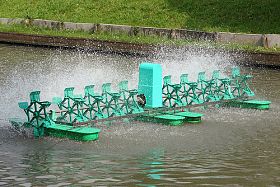 US aquaculture industry alone, millions of dollars a year. In order to try and mitigate disease outbreaks from occurring, it is important that good biosecurity is applied on the fish farm.
US aquaculture industry alone, millions of dollars a year. In order to try and mitigate disease outbreaks from occurring, it is important that good biosecurity is applied on the fish farm.The pressure from disease organisms is continuing to rise as aquaculture operations intensify. While Recirculating Aquaculture Systems are more sheltered from the introduction of pathogens, pond and cage operations are more exposed to the environment and therefore to disease. In general, biosecurity is the prevention of the introduction and spread of a disease from one place to another.
On the fish farm, there are seven vectors that can lead to the introduction or spread of a disease or infection: Introduction of fish/ fish eggs, water, equipment, vehicles, human and/or animal contact, feed and fish health (stress). In order to address these areas, a good biosecurity plan is needed.
Before implementing a biosecurity plan, it is important to understand what the disease risks are, how vunarable the farm is to disease and how healthy the fish are currently.
Water
The water in which fish live can become contaminated by feces, urine, reproductive fluids and mucus from diseased fish, so it is important that water is filtered, disinfected and cleaned regularly.
The water itself should be from pathogen free and uncontaminated sources such as ground water or natural springs. When this is not possible, water should be treated before use. This is often done through the use of ozone or ultraviolet radiation.
Open ponds and cages may also be a risk from urine and feces from birds and other wildlife, so good predator management needs to be in place.
Human and/or animal contact
Visitors to the farm should be recorded in a visitors log book and should wear appropriate protective clothing while on the farm, which can be regularly cleaned and disinfected.
Foot baths are a useful piece of equipment to prevent possible infected material from being transferred around and onto a farm. These should be kept clean of debris and the disinfectant concentration should be monitored.
Vehicles and Equipment
Contamination of vehicles and equipment can easily spread disease onto or throughout a farm. To prevent this from happening, separate equipment should be used for each site/pond or task and traffic should be kept to a minimum. It is also good practice to select equipment that can be efficiently cleaned and disinfected and vehicles should enter and leave farms through controlled points so that they can be disinfected.
Ponds, raceways and tanks should also be disinfected prior to the stocking of a new batch of fish.
The general protocol to cleaning equipment is as follows:
1. remove visible debris
2. wash with soap and water and rinse
3. apply disinfectant
4. rinse
5. alow to dry
There are a variety of disinfectants that can be used. Make sure you follow the manufacturer's directions to use products correctly.
Introduction of new fish/eggs
Any new fish or eggs brought onto the farm should have certification of disease free status, as this will prevent sick fish from contaminating fish already on the farm. Using specific pathogen free fish and eggs is also thought to prevent any diseases from entering.
Movement of fish on the farm, for stocking or separating, for example, should also be minimized.
Feed
It is often safer to use pasteurized feeds as these have been treated in a way which removes any bacterial, viral, or parasitic pathogens which could introduce disease.
Similar to practices for the introduction of new fish to a farm, any non-pasteurized fish meal should be free of disease and have come from wild stocks which are certified as being free of diseases.
Fish Health and Stress
Fish that are stressed or that are not vaccinated are more susceptible to disease. It is therefore good practice to maintain good health and welfare of fish. You can read more on the health and welfare of fish here.
A good diet and the immediate removal of any dead or sick fish will also minimize the chance of diseases spreading.





